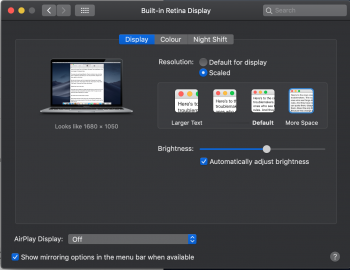I just purchased the new 13inch MacBook Air.
It has a resolution of 2560 x 1600 according to specs, but when I got to Settings > Display, the maximum option I can choose is "More Space" which says its "1680 x 1050"
Am I doing something wrong or am I just not understanding how these modern retina displays work. Happy to be educated.
Of if there is a way to get higher resolution (so everything is just a bit smaller) then I'd love to know how.
Thanks
It has a resolution of 2560 x 1600 according to specs, but when I got to Settings > Display, the maximum option I can choose is "More Space" which says its "1680 x 1050"
Am I doing something wrong or am I just not understanding how these modern retina displays work. Happy to be educated.
Of if there is a way to get higher resolution (so everything is just a bit smaller) then I'd love to know how.
Thanks



